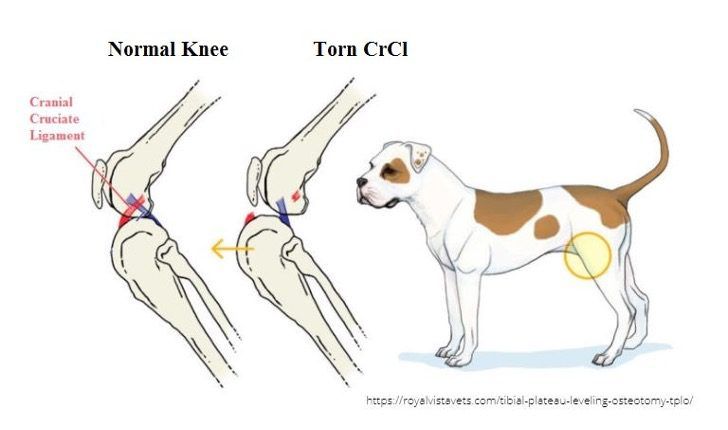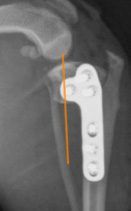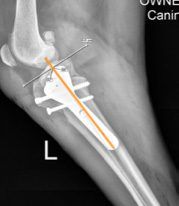CBLO Surgery for Cranial Cruciate Disease
The most common cause of hind limb lameness in dogs is damage to the cranial cruciate ligament (CrCL) in the “stifle”, which is another word for the knee. The CrCL is the same structure that is known as the anterior cruciate ligament (ACL) in humans, which is commonly injured in sports activities. While dogs knees have a similar structure to human knees, the orientation and forces applied to their stifles are different. Therefore, the ways veterinarians address these injuries are different than those of human orthopedists.
There are several functions of the CrCL in the canine stifle. The CrCL prevents rotation of the tibia (shin bone) to the inside of the stifle. In addition, the CrCL prevents the tibia from sliding forward when weight is placed on it by the femur (thigh bone). The top of the tibia actually has a slant, which makes the front of the tibia higher than the back. The difference between the front and the back creates the “tibial plateau angle” (TPA). The TPA is an important factor in both how the CrCL is injured, and how we address the injury. When this slope is steep (and the TPA is greater), there is more tension on the CrCL compared to when the slope is gentle (and the TPA is less).
When our canine pets injure their CrCL, it is usually considered part of a degenerative process. The CrCL undergoes small “micro-tears” that wither it, like an old cotton rope. What pet parents tend to see are occasional bouts of lameness in their dog that occur after activity. Often the lameness goes away after a few days as the inflammation decreases, only to return when they have another micro-tear. Once a moderate portion of the CrCL is compromised, normal use of the leg becomes difficult. The absence of a normal CrCL, allows the tibia to slide forward relative to the femur, causing stress on the joint and often causing damage to the meniscus (the same structure found in humans that acts like a cushion between the femur and tibia).

There are multiple surgeries that can be used to address a canine stifle with a torn CrCL. The most popular is the tibial plateau leveling osteotomy (TPLO), which was developed about 30 years ago. The TPLO addresses the tendency of the femur to slide backward down the slope of the tibia when the CrCL is torn by changing the angle of the slope.
A refinement to the concept of the TPLO , known as the Cora (Center of Rotational Axis) Based Leveling Osteotomy (CBLO) was developed around 2008. Similar to the TPLO, the CBLO also decreases the angle of this slope, but in a slightly different manner that avoids some of the complications seen with a TPLO, and patients typically have a faster recovery time.
There are other surgeries to address a CrCL deficient stifle. They each have their strengths and weaknesses; the details of which are beyond the scope of this article.
Dr. Respet has concentrated on performing surgeries on the canine stifle for over a decade. While trained to do four different types, he recommends the CBLO surgery for medium and larger breed dogs.
There are several characteristics of the CBLO surgery that can have both short term and long term benefits compared to a TPLO.
- In both CBLO and TPLO surgeries, a cut is made in the tibia. With a CBLO, the center of force that is placed on the stifle is positioned so that it is directly over the center of the tibia.(see image below). Conversely, the TPLO can cause the center of force to be over the posterior (back) aspect of the bone. In extreme cases, the center of weight can even be behind the bone. This often referred to as a “balcony effect”. This causes a functional limb deformity and can significantly alter the mechanics of the joint. (see image below)
- The cut for the CBLO is below the stifle joint, and therefore, does not interrupt the joint. The TPLO involves a cut through the front of the stifle joint.
- When we are examining your pet’s stifle, we will try to shift the tibia forward. This is called a “drawer test”. There is less “drawer” movement after a CBLO in the stifle compared to a TPLO in a standing angle. It is this movement that causes damage to the meniscus and is a significant factor in the development of arthritis.
- A CBLO is the only surgery for a CrCL deficient stifle that can be performed in juvenile dogs that still have open growth plates.
- A CBLO can be coupled with surgery to correct for medial patellar luxation (where the knee cap slips to the inside of the knee)
- In our experience, patients with a CBLO often return to normal activity faster.

An example of “balcony effect”, where the center of weight (orange line) is well behind the center of the bone.
(Images complements of Hulse 2017)

An example of a CBLO where the center of weight (orange line) is in alignment with the center of the bone.
(Images complements of Hulse 2017)
Both CBLO and TPLO surgeries address the CrCL deficient stifle with similar methodology. Both have very good success rates and are considered the gold standard for this orthopedic problem. While opinions may vary, we find that the CBLO allows us to address a wider array of individual variations in patients with great short term and long term comfort and success.
Useful links:
- Second-look arthroscopic findings after CORA-based leveling osteotomy
- Owner Evaluation of a CORA-Based Leveling Osteotomy for Treatment of Cranial Cruciate Ligament Injury in Dogs
References: lKishi EN, Hulse D. Owner Evaluation of a CORA-Based Leveling Osteotomy for Treatment of Cranial Cruciate Ligament Injury in Dogs. Vet Surg. 2016;45(4):507-514. doi:10.1111/vsu.12472
Raske M, Hulse D, Beale B, Saunders WB, Kishi E, Kunze C. Stabilization of the CORA based leveling osteotomy for treatment of cranial cruciate ligament injury using a bone plate augmented with a headless compression screw. Vet Surg. 2013;42(6):759-764. doi:10.1111/j.1532-950X.2013.12035.x
Vasquez B, Hulse D, Beale B, Kerwin S, Andrews C, Saunders BW. Second-look arthroscopic findings after CORA-based leveling osteotomy. Vet Surg. 2018;47(2):261-266. doi:10.1111/vsu.12708
